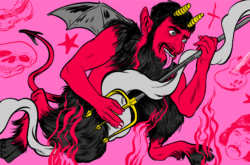Having an effective score may be more important to horror movies than any other genre.
A good horror movie creates an inescapable sense of immersion, and sound is a key player for viscerally drawing us into a story. Over the last several decades, composers have explored and innovated many techniques for elevating the fear factor of a film, from blurring the lines between music and sound design to maximizing the deafening power of silence.
In the spirit of Halloween, a few of our blog’s authors came together and shared the film scores that stood out to them. While by no means an exhaustive list, we present you some of the most iconic horror movie scores throughout history.
Psycho (1960)
Ken: Bernard Herrmann’s soundtrack might be the single most important element of Psycho, with Alfred Hitchcock himself famously remarking, “33% of the effect of Psycho was due to the music.” Herrmann’s amalgam of screeching violins, violas, and cellos in “The Murder,” the composition that plays during the shower scene, is easily one of the most recognized pieces in horror and cinema at large. The film’s use of tense, uncomfortable music in the first half of the movie (where nothing violent happens) also keeps the audience on their toes by hinting at the sinister events that lie ahead.
Suspiria (1977)
Shannon: The soundtrack to the original 1977 film Suspiria was composed and performed by the Italian prog-rock band Goblin, led by Claudio Simonetti, a Brazilian-born Italian musician and film composer. Simonetti collaborated with Dario Argento on several of his films, with the soundtrack of Suspiria being arguably the most notable.
In an interview with Fact Magazine, Simonetti explained their process for the Suspiria soundtrack, which started with a set of demos they made after reading the script. He said, “We tried to use a lot of ethnic instruments like tabla and bouzouki, and we did a lot of recording of sounds that we created because, in 1977, we didn’t have any samplers.” He added, “Dario used this music on the set, to help the actors during the shooting.” However, in the end, Simonetti scrapped the original demos because they didn’t share the film’s distinctive mood. He said in the interview, “When you write the music from the script, I don’t know why, but it doesn’t work.”
Instead, he took an experimental direction, becoming one of the first to use a synthesizer in a film score, leaning heavily on the System 50 Moog modular system famously used by Emerson Lake & Palmer’s Keith Emerson. Goblin’s music went on to inspire John Carpenter among other great horror movie composers and directors.
The Shining (1980)
Matteo: Sometimes, a few notes is all it takes to make your skin crawl. In the case of Stanley Kubrick’s The Shining, those iconic opening notes to the main theme give me goosebumps every single time I hear them. Composers Wendy Carlos and Rachel Elkind actually adapted this phrase from Hector Berlioz’s “Symphonie Fantastique,” which in turn drew from a well-known medieval hymn.
The usage of a synthesized horn gives the melody an unnatural feel as other sonic elements begin to appear, from thin metallic string plucks to haunting vocal chants. This unsettling soundscape is incredibly minimal, but sets the scene perfectly for what’s to come.
The Thing (1982)
Matteo: Hitting theaters on the same weekend as E.T., John Carpenter’s 1982 alien horror flick The Thing wasn’t well-received by critics at the time, but has since become a modern cult classic. A remote Antarctic research base and an alien parasite that imitates other lifeforms — you can imagine the chaos that ensues! Carpenter, who traditionally scored his own films with a focus on analog synthesis, tapped the legendary composer Ennio Morricone for this project. A peculiar choice, but the soundtrack really connects to the film’s plot, with its dissonant orchestral strings combining with dark, foreboding drones in a twisted symphony.
Opting for more electronic elements in the main theme, Morricone introduces a pulsing “dum-dum” motif that reappears throughout the film. Could this be the alien’s attempt at imitating our own human heartbeat, and Morricone imitating the same musical themes that Carpenter was known for? It certainly fits in with the film’s tagline: “Man is the warmest place to hide.”
A Quiet Place (2018)
Ken: As the title suggests, A Quiet Place is all about sound, or the lack thereof. Compositions from Marco Beltrami such as “A Quiet Life” are carefully inserted and fit amazingly with the film, but what’s equally impressive with A Quiet Place is the various techniques employed in its sound design. On the set of the film, crew members avoided making any noise so natural and diegetic sounds could be recorded on the soundstage and amplified in post-production. Sound designers Erik Aadahl and Ethan Van der Ryn used different levels of filters and hum to emphasize silence in scenes where Regan turns her cochlear implants on and off. To design the sound of the screaming creatures, they squished wet rags and pulled watermelon husks apart. All of these creative choices combine to create a one-of-a-kind film that’s as emotionally impactful as it is scary.
Us (2019)
Shakeil: Us, Jordan Peele’s second horror classic, is a terrifying and at times hilarious rumination on class, the United States, and rabbits. Music plays a central role throughout the film, driving the plot forward, ratcheting up the intensity in its absence, and even offering moments of comic relief when the terror begins to go off the rails. The introductory track, “Anthem,” is spooky-as-hell yet also makes you want to groove, with later songs like “Beach Walk” and “Once Upon a Time” reusing percussive and choral elements that appear in “Anthem” in cohesive and chill-inducing ways. Michael Abels’ work across the score is exceptional, using frantic strings and varied percussion throughout, but his rework of Luniz’s “I Got Five On It” elevates the entire score to iconic status. His orchestral rework that plays during the climax of the film is a masterwork in re-contextualization, drawing out and dramatizing the melody. Lastly, Us has undeniably the best use of NWA’s “Fuck the Police,” in any film ever. Quote me on that.
What’s the most iconic horror movie score in your book? Let us know in the comments below.
October 31, 2019


